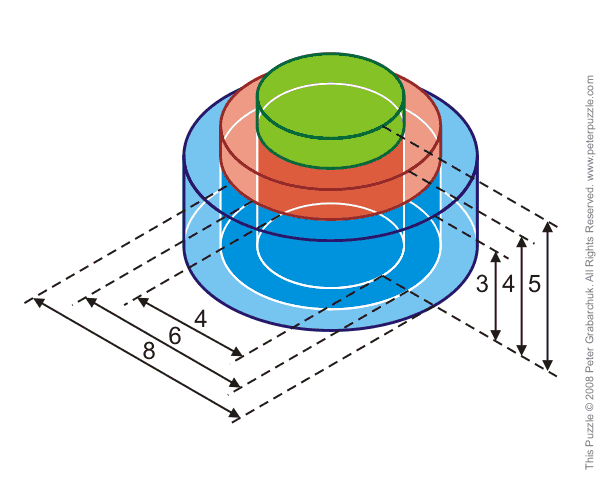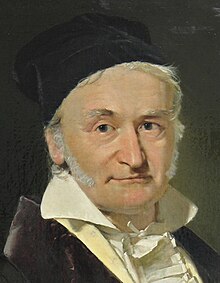1. Parametrize the curve $y^2+y=x^2$ using as the parameter $t$ slope of the line from the origin to a point on it, i.e. $y=tx$.
The first thing we should do is substitute $tx$ for $y$ in the first equation to obtain $$ \left(t^2-1\right)x^2+tx=0. $$ By the quadratic equation, we find that $$ x=-\frac{t}{t^2-1}\quad\text{or}\quad x=0. $$ To find $y$ in terms of $t$, we substitute this $x$ into the second equation to obtain $$ y=-\frac{t^2}{t^2-1}\quad\text{or}\quad y=0. $$ Therefore, the parametric equation of this curve is $$ r\left(t\right)=\begin{cases} -\frac{t}{t^2-1}\partial_x+-\frac{t^2}{t^2-1}\partial_y & \text{ if } t\in\mathbb{R}\setminus\{-1,1\}, \\ 0\partial_x+0\partial_y & \text{ if } t\in\{-1,1\}. \end{cases} $$ 2. The evolute of the parabola $y=x^2/2$ is $y=1+3/2x^{2/3}$. How many normals can be drawn to this parabola from $\left(1,-1\right)$? Explain.
Substituting this point into the evolute's equation yields $$ y\left(1\right)=\frac52>-1. $$ In other words, the point is below the evolute.
Some time ago, we concluded that under the evolute or on its cusps, only one normal can be drawn; above the evolute, only three normals can be drawn; and on the evolute, only two normals can be drawn.
Therefore, only one normal can be drawn.
3. Consider the curve $r\left(t\right)=e^t\left(\sin t-\cos t\right)\partial_x+e^t\left(\sin t+\cos t\right)\partial_y$ with $t\in\mathbb R$.
a. Find the speed.
The speed is defined as follows: $$ v=\left|r'\right|. $$ Therefore, we have that $$\begin{align} r'\left(t\right)&=2e^t\sin t\partial_x+2e^t\cos t\partial_y,\\ \left|r'\right|&=2e^t=v. \end{align}$$ b. Find a natural parameter.
The natural parameter is defined as follows: $$ s=\int v\,dt. $$ Therefore, we have that $$ s=2e^t+c. $$ c. Find involutes.
Involutes are defined as follows: $$ h=r-T\int v\,dt. $$ Therefore, we have that $$\begin{align} T&=\frac{r'}{v}=\sin t\partial_x+\cos t\partial_y,\\ h&=-\left[\left(e^t+c\right)\sin t+e^t\cos t\right]\partial_x+\left[e^t\sin t-\left(e^t+c\right)\cos t\right]\partial_y \end{align}$$ 4. Consider the curve $r\left(t\right)=t\partial_x+\ln\cos t\partial_y$ with $t\in\left(-\pi/2,\pi/2\right).$
a. Find the speed.
Hint: $1+\tan^2t=\sec^2t$.
As before, we have that $$\begin{align} r'\left(t\right)&=\partial_x-\frac{1}{\cos t}\sin t=\partial_x-\tan t\partial_y,\\ v&=\sqrt{1+\tan^2t}=\sqrt{\sec^2t}=\sec t. \end{align}$$ b. Find the unit tangent.
As before, we have that $$ T=\cos t\partial_x-\sin t\partial_y. $$ c. Find the right unit normal.
The right unit normal is defined as follows: $$ \tilde N=-T_2\partial_x+T_1\partial_y. $$ Therefore, we have that $$ \tilde N=\sin t\partial_x+\cos t\partial_y. $$ d. Find the signed curvature.
The signed curvature is defined as follows: $$ \tilde\varkappa=\frac{r'\times r''}{v^3} $$ Therefore, we have that $$\begin{align} r''\left(t\right)&=-\sec^2t\partial_y,\\ r'\times r''&=\begin{vmatrix} 1 & -\tan t\\ 0 & -\sec^2t \end{vmatrix}=-\sec^2t,\\ \tilde\varkappa&=-\cos t. \end{align}$$ e. Find the principal unit normal.
The principal unit normal is defined as follows $$ N=\text{sign}\left(\tilde\varkappa\right)\tilde N. $$ Therefore, we have that $$ N=-\sin t\partial_x-\cos t\partial_y. $$ f. Find the evolute.
The evolute is defined as follows: $$ c=r+\frac{1}{\tilde\varkappa}\tilde N. $$ Therefore, we have that $$ c=\left(t-\tan t\right)\partial_x+\left(\ln\cos t-1\right)\partial_y. $$ 5. Fill in the blanks to form a true statement.
a. If the speed is $3$ and $T=\partial_x$, then the velocity is "$3\partial_x$."
b. Natural parameter is unique up to "shift and sign change."
c. A plane has "two" unit normals.
d. Inflection point is where a curve "has $\varkappa=0$."
e. If the curvature is $\varkappa=e^{2t}+1$ and the natural parameter is $s=e^t$, then the natural equation of the curve is "$\varkappa\left(s\right)=s^2+1$."
f. Lines and circles are the only plane curves that "have constant curvature."
g. The unit tangent to a curve is drawn below, draw and label $N$ and $\tilde N$.

h. Tangents to a plane curve are normal to "its involutes."
i. Wavefronts of a plane curve have cusps on "its evolute."
j. Involute of the evolute is "a wavefront of the plane curve."
6. Prove that $\ddot T\cdot T=-\varkappa^2$, where $T$ is the unit tangent and $\varkappa$ is the curvature of a curve.
Hint: Differentiate $\dot T\cdot T$.
Proof. $\dot T=\varkappa N\Longrightarrow\dot T\cdot T=\varkappa N\cdot T=0$.
$$\begin{align}
\frac{d}{dt}\left(\dot T\cdot T\right)&=\ddot T\cdot T+\dot T\cdot\dot T=\ddot T\cdot T+\left|\dot T\right|^2\\
&=\ddot T\cdot T+\left|\varkappa N\right|^2=\ddot T\cdot T+\varkappa^2=0\\
&\Longrightarrow\ddot T\cdot T=-\varkappa^2.\qquad\square
\end{align}$$
7. Let $r\left(t\right)$, $w\left(t\right)$ be two curves that are normal to the segment connecting them at each point, i.e. $r'\perp\left(w-r\right)$ and $w'\perp\left(w-r\right)$. Prove that they are equidistant, i.e. $\left|w-r\right|=\text{const}$.
Hint: Differentiate $\left|w-r\right|^2=\left(w-r\right)\cdot\left(w-r\right)$.
Proof. $$\begin{align} \frac d{dt}\left[\left|w-r\right|^2\right]&=\frac d{dt}\left[\left(w-r\right)\cdot\left(w-r\right)\right]\\ &=2\left(w'-r'\right)\cdot\left(w-r\right)\\ &=2\left[w'\cdot(w-r)-r'\cdot(w-r)\right]=0.\qquad\square \end{align}$$












